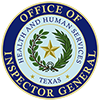The OIG shares contract monitoring lessons from audits, inspections and investigations
The Office of Inspector General’s commitment to preventing fraud, waste and abuse includes conducting investigations and risk-based audits related to HHS contracts. Investigations and audits can reveal weaknesses in internal controls, contract monitoring and oversight. Contract monitoring ensures that a vendor adequately performs the service the state pays it to perform.
To assist programs in strengthening their contract monitoring and oversight, the OIG team has compiled lessons learned based on findings from our work. In addition, the following observations by OIG auditors, inspectors and investigators provide opportunities for the agency to continue to strengthen its contract oversight activities:
Ensure the ratio of contract managers to contracts is reasonable
Contract monitoring is labor-intensive. Having adequate resources assigned to oversee a contract helps ensure a successful contract life cycle. A balanced ratio of contracts for each contract manager that considers the complexity and type of purchase facilitate effective oversight.
Strengthen policies and procedures
Written policies and procedures, including the HHS Procurement and Contract Management Handbook, help ensure a consistent, high-quality contract monitoring process. In addition, specific procedures should include guidance on conducting quality assurance of contracts to verify compliance with federal and state laws.
Enhance training for contract managers and staff
Staff training in contract monitoring policies and procedures increases the likelihood that individuals will monitor contracts reliably. Findings in OIG investigations, audits and inspections can often be traced back to lack of training and lack of clear contract monitoring policies and procedures.
Communicate clear expectations to vendors
Planning is integral to contract monitoring. When developing a procurement, the agency should define the clear outcomes, including deliverables and expectations, that will determine success throughout the contract life cycle.
Develop specific contract monitoring plans for high-risk contracts
A detailed contract monitoring plan listing expected and completed activities can be used throughout the contract period to mitigate risk for higher-risk contracts. A tailored plan helps ensure the process continues, even if staffing changes occur.
Maintain contract files in SCOR as required
Contract files should be maintained in the System of Contract Operations and Reporting (SCOR) as required by the Procurement and Contract Management Handbook, and any supplemental files should be organized so that someone can reconstruct and understand the history of the contract.
Consistently link payments to satisfactory performance
Educating first-time and veteran contract holders helps ensure that invoices received and payments made are only for goods or services supported by the contract. OIG auditors and investigators have observed invoice approval without proper review or lacking evidence that work was completed as required.
Conduct on-site monitoring
For certain contracts, as directed by an agency’s risk-based monitoring plan, agency officials should conduct random vendor record reviews to ensure key contract terms are fulfilled. On-site monitoring visits are most effective when based on a specific methodology or a checklist of review tasks.
Include access to records and right-to-audit clauses in all contracts
Agencies are responsible for verifying that information from vendors is accurately reported and ensuring that funds are appropriately expended. Therefore, the contract must stipulate that the agency, the OIG, and other oversight entities have the authority to access and audit contractor records at any point during or after the contract term. Contracts should also require subcontractors to provide access to records.
An effective contract monitoring system can mitigate risk and prevent errors. For the OIG, auditing contracts are part of its statutory duties related to preventing and detecting fraud, waste and abuse.

